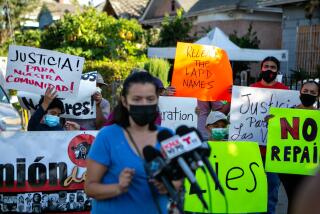Study Urges Ban on Fireworks Sales
On the high holy day of Americaâs love affair with incendiary amusements, the largest study yet of children injured by fireworks has found such a toll of burns, cuts and blindness that the researchers are calling for a federal ban on private sales of all fireworks, from bottle rockets to lowly smoke pellets.
The study, published today by the American Academy of Pediatrics, found that 316 children were treated for fireworks injuries at Childrenâs Mercy Hospital in Kansas City, Mo., from 1972 through 1993. Among those injured, 72% were burned; 17% were cut, bruised, scraped or pierced; 2% suffered permanent partial or total vision loss, and 5% had to be operated on. One child was killed, by an M-1000, which packs one-third the wallop of a stick of dynamite.
âI was most struck by the severity of the injuries,â said Dr. Gary Smith, an emergency medicine specialist and epidemiologist who led the study. âA lot of these were devastating injuries that really changed kidsâ lives.â
The average cost of the injuries, Smith and co-workers found, was $1,385.
Because the researchers analyzed hospital records, they were not able to calculate what percentage of children who play with fireworks get hurt. Still, the study offers an uncommonly detailed look at the downside of such recreational explosions, which injure about 6,000 children and 6,000 adults annually, according to the U.S. Consumer Products Safety Commission.
California already bans firecrackers, rockets and sparklers, which pose fire hazards as well as health hazards. But many residents bring in such explosives from Nevada and Mexico, and via mail. Under state law, communities may opt to sell âsafe and saneâ fireworks, including smoke pellets, pinwheels, and party poppers for use in those communities only.
The state fire marshal reports that legal and illegal fireworks caused 329 injuries last year.
Deputy Ellie Shelton, the state fire marshalâs fireworks program coordinator, said nearly all reported injuries from âsafe and saneâ fireworks were caused by items that had been misused or illegally modified to produce more bang.
âAs long as you use âsafe and saneâ [fireworks] in a sane manner,â she said, âtheyâre safe.â
The National Fire Protection Assn., a nonprofit policy group in Quincy, Mass., has long advocated a complete ban on fireworks of all kinds, urging people to leave patriotic displays of the rocketsâ red glare to licensed professionals.
â âSafe and saneâ fireworks are neither,â says the current NFPA Journal.
In the Kansas City study, the researchers found that adult supervision, often cited as the key to safe pyrotechnics, was not that helpful: An adult was present at the time of injury in 54% of cases. In 26% of cases, the child injured was not setting the device off but merely watching nearby.
By calling for a ban on all classes of retail fireworks to protect children, the researchers have been criticized for, in effect, recruiting the government to take the place of parents.
But the âthe best-caring parents in the worldâ cannot prevent these split-second injuries, said Smith, who is now director of emergency medicine at Childrenâs Hospital in Columbus, Ohio.
Among the studyâs other findings, 70% of the injured children were boys, 67% of sparkler injuries were suffered by youngsters 5 and under, and 52% of the injuries happened on July 4.
(BEGIN TEXT OF INFOBOX / INFOGRAPHIC)
Fireworks Injuries
Analyzing medical records of children injured by fireworks at a hospital in Kansas City, Mo., researchers found 316 cases from 1972 through 1993. Most were burns, but the findings also include major eye injuries. Nearly all injuries occurred in the three weeks from late June to mid-July. Here is a look at how the children were hurt:
Firecracker: 42%
Bottle Rocket: 12%
Roman Candle: 11%
Other Rocket: 7%
Sparkler: 7%
Fountain: 5%
Jumping Jack: 4%
Gunpowder: 2%
Other: 9%
****
*--*
No. of Circumstance* Children % Holding in hand 55 22% Thrown device 37 15% Device malfunction 23 9% Hit by bottle rocket 21 8% Flying sparks/fireballs 21 8% Explosion nearby 19 8% Explosion in container 14 6% Bending over to light 13 5% Ignited in pocket 13 5% Altered device 7 3% Dropped into shoe 4 2% Other 23 9%
*--*
* There were 66 children with unknown injury circumstances.
More to Read
Inside the business of entertainment
The Wide Shot brings you news, analysis and insights on everything from streaming wars to production â and what it all means for the future.
You may occasionally receive promotional content from the Los Angeles Times.









